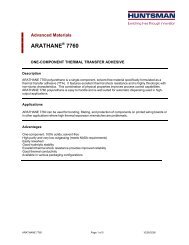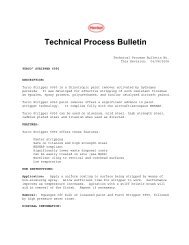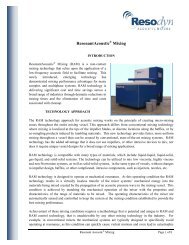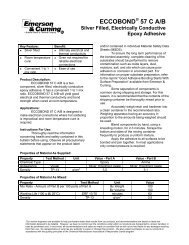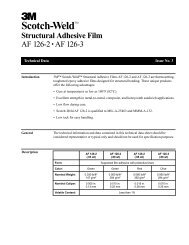Composite Peel Ply - EV Roberts
Composite Peel Ply - EV Roberts
Composite Peel Ply - EV Roberts
- No tags were found...
Create successful ePaper yourself
Turn your PDF publications into a flip-book with our unique Google optimized e-Paper software.
Product DescriptionHysol EA 9895 <strong>Peel</strong> <strong>Ply</strong> is a resin impregnated polyester peel plyFilm weight: 0.034PSFProduct ObjectiveCure is compatible with tough CF prepregsGenerates very bondable surfaces on cured compositesSanding and solvent wiping not requiredPromotes cohesive failure in the adhesiveCompared to interfacial failures generated by dry peel ply fabricspage
Hysol EA 9895 <strong>Peel</strong> <strong>Ply</strong>Resin impregnated polyester peel ply350°F CureArial weight - 0.034 lb/ft 248% resin content – fabric @ 0.018 lb/ft 2Typical properties977-2 adherends / Hysol EA 9695 adhesive<strong>Peel</strong> ply stripping force – 3.7 inlb/in 2G Ic – 4.4 inlb/in 2G IIc – 21.4 inlb/in 2page
Key Features & Customer BenefitsFeaturesGenerates more durable bondingsurface than dry fabricFailure mode is cohesiveCompatible with third generationcomposites, 977-2No sanding or solvent wipingrequired of bonding surfaceMinimal force required to removepeel ply layerProtective layerGood shop lifePerforms well with HysolEA 9695 composite bonding film BenefitsPart longevity/reduced maintenancecostsConsistent bonding surfacePerforms well with tough state ofthe art compositesProcess aid that assures consistentsurface prepMinimizes surface prep time andergonomically friendlyPart storage/handling2-3 weeksPromotes/enables Hysol adhesivespage
Comparative DataTest ProcedureMultiple plies of 977-2 composite cured with prepreg peel ply on thesurface(s) to be bonded<strong>Peel</strong> <strong>Ply</strong> is removed from the surfaceRemoval force is importantTwo panels are bonded together using Hysol EA 9695 filmNo surface abrasion or solvent wiping* neededG Ic and G IIc measured for resulting secondary bonded panelAll Airbus testing was very similar to BMS 8-308* No solvent wiping needed if bonded immediately after the removal of the peel plypage
<strong>Composite</strong> Bonding to Precured Skins with <strong>Peel</strong> <strong>Ply</strong>SurfacesProblem StatementslPolyester and nylon are inherently difficult to wet by epoxyresins.Polyester: 42-43 dynes/cmEpoxy: 47-55 dynes/cmlFibers are found on the substrates that were surfaceprepared with most commercially available polyester peelplies.lThe amount of residual fiber on the substrate may adverselyimpact the bond performance.page
Relative Performance of Adhesive BondsEA9895SandingPolyester <strong>Peel</strong> <strong>Ply</strong>Nylon <strong>Peel</strong> <strong>Ply</strong>0 1 2 3 4 5 6 7 8Relative Performancepage
S60001 Removed from Substrate50 x 50 filaments/towDiameter: 19umAfter removed fromsubstrateBefore use<strong>Peel</strong>surfacepage
<strong>Composite</strong> Surface after Hysol EA 9695with Polyester Dry <strong>Peel</strong> <strong>Ply</strong> RemovedTop viewSide view“Dry” fibers that do not providean optimum bond surface<strong>Peel</strong> ply sidepage
Wet <strong>Peel</strong> <strong>Ply</strong> AttributeslEase of removallMinimal residual polyester fibers on substrate afterremovallGood G Icvalue/performanceThin residual resin layerlControlled failure/release pathWeak interfacial strengthLower toughness than laminate and adhesivepage
EA9695 / Ultraply G Wet <strong>Peel</strong> <strong>Ply</strong>G 1c Cross-Section before testReleasedregion ofthe wetpeel plyAdhesiveResidual <strong>Peel</strong> <strong>Ply</strong> Fiber<strong>Composite</strong>Substratepage
Hysol EA9895 / F08111 Wet <strong>Peel</strong> <strong>Ply</strong>G 1c Cross-Section before testNo visible Residual <strong>Peel</strong> <strong>Ply</strong> FibersReleasedregion of thewet peel plypage
Cured <strong>Peel</strong> <strong>Ply</strong> Stripping Force655.2<strong>Peel</strong> <strong>Ply</strong> Stripping Torque, in.lb./in4323.710<strong>Peel</strong> <strong>Ply</strong><strong>Peel</strong> <strong>Ply</strong>Hysol EA 9695 Hysol EA 9895WetWetpage
Surface Characterization9008007006005004003002001000765GIc, J/m2415465Dry Wet EA9695 EA9895page
Typical Hysol EA 9695 with <strong>Peel</strong> <strong>Ply</strong>Prepared G IcFracture SurfaceCorrespondingAreas of BondSide 1Side 2page
Typical F161/60001Prepared G IcFracture SurfaceCorrespondingAreas of BondSide 1Side 2page
EA9895G 1c Fracture SurfaceCorrespondingAreas of BondSide 1Side 2page
PL795 <strong>Peel</strong> Testing with Dry and Wet <strong>Peel</strong> <strong>Ply</strong>Dry <strong>Peel</strong> <strong>Ply</strong>Wet <strong>Peel</strong> <strong>Ply</strong>page
Why do “dry” fabrics give lower performance?<strong>Peel</strong> ply fiber remains on surface after fabric removalPoor bonding to this fiberSubsequent bond fractures at this fiberLower strength levelspage
Hysol EA 9895 <strong>Peel</strong> <strong>Ply</strong> SummaryHysol EA 9895 <strong>Peel</strong> <strong>Ply</strong>Polyester peel ply fabricSpecially designed resin system350°F (180°C) cure temperatureCompatible with high toughness prepreg resinsEliminates fiber retention on bonding surfaceFabric strips easily in one pieceResultant resin surface very compatible with adhesive bondingpage
<strong>Composite</strong> ATP FabricationEA9895 Facilitates ATPprocess on Airbus A380composite fabricationprocess• Aggressive tack secureslay up to mandrel during tapeplacement• Skin surface thus preparedaffords good bond surface forstringer co-bond attachmentwith EA9695page
Benefits & Limitations of EA9895 v.CompetitionDry <strong>Peel</strong> PliesInexpensiveRelatively unlimited shelf, handling lifeProduces poorly prepared surfaces for bonding compared to wet peel plyRisk of fiber residue left on partNo tack, difficult to use on vertical assembliesEA9895Affords excellent surface for bondingLeaves no residual fiber on partAggressive tack suitable for vertical lay up facilitationHexcel: Hexply wet peel plies (various)Affords better bonding surface than dry peel pliesLoses tack quicklyCytec: Various wet peel plies based on prepreg matrix chemistriesNot much knownCytec will claim better chemical compatibility, but not proven to be a benefit in performance of adhesive bondpage
ConclusionIn general, dry <strong>Peel</strong> Plies are difficult to removeDry and wet peel plies have the potential to leave residualfibers on the released substrates, leading to loweradhesion performanceHenkel has the technical understandings to successfullydeveloped a capable wet peel plyEA9895 Wet <strong>Peel</strong> <strong>Ply</strong> is availablepage
Thank youpage









